Microsoft BUILD: Windows 8, A Pre-Beta Preview
by Brian Klug & Ryan Smith on September 13, 2011 12:05 PM EST- Posted in
- BUILD
- Windows
- Microsoft
- Windows 8
- Trade Shows
Mobile Experience Side
Coming from the smartphone side of things, I really see many shades of WP7 inside Windows 8. That’s actually dramatically understating the state of things - the core of what we’ve been shown of Windows 8 that’s new literally is either adopted from or directly analogous to much of WP7.
It doesn’t come as a surprise to me at all that the desktop Windows experience is moving in this direction, (and it seems as though the Xbox 360 interface will follow shortly). The positive result is that Windows 8’s touch experience feels much closer to the ground-up approach Android Honeycomb or iOS have taken than the than the “Tablet-Edition” versions of Windows XP and the tablet integration in Vista and 7. I used a UMPC and remember Origami and how that application lived as its own standalone mode of operation as an application within windows. What Windows 8 is the inverse - Windows now lives inside a Metro-themed Start screen that looks like WP7 for the desktop. Or at least it does in this demo we’ve been shown currently.
The tablet experience is now absolutely on par with modern mobile OSes - sure there are a few more things that need to be included, but the foundation is there for Windows to suddenly become more than an OS that also can do touch-based interaction.
IE 10
Microsoft has been actively promoting IE 10 since MIX 11, with two platform previews so far, and IE 10 is an integral part of Windows 8 both as a browser and as a runtime for HTML based Metro applications. We won’t go into exacting detail about what’s new and interesting inside IE10, beyond mentioning that it improves upon IE 9’s GPU acceleration and improves web compliance support including CSS3. What’s relevant in Windows 8 is that IE 10 gets two views - one belonging to the Metro-heavy start menu experience, which we’ll call the mobile view, and the other belonging to the traditional desktop windows view.
This dichotomy exists between the two IE10 experiences, which is in itself a bit curious. The mobile view is almost exactly what IE looks like inside Windows Phone 7.5 - at the bottom is the URL bar and controls, and with a slide down gesture, at the top are tabs. Meanwhile the IE10 desktop experience uses the older IE 9 UI. At this point, it doesn’t appear that windows opened in one are transportable to the other.
The mobile view is almost exactly like WP7.5’s however, the URL bar disappears when scrolling, and the browser supports a completely fluid multitouch experience that feels speedy.
Cloud
Windows 8 offers considerable integration with Windows Live and SkyDrive. Local user accounts can be directly tied to a Live account on trusted PCs, and then be used for live roaming. Live roaming enables each connected device to access the same set of accounts for photos, email, calendar, and contacts and speed up initial setup. For example, photos captured on a WP7.5 device’s camera roll can be immediately visible on a Windows 8 PC authenticated against the same Live account. This is very close to how camera roll will integrate into Apple’s iCloud and synchronize across iOS and OS X Lion.
One thing is clear, and it’s that Microsoft plans to heavily integrate and leverage its Live services into Windows 8 and provide an ecosystem-wide way to migrate accounts settings, photos, and data between mobile, tablet, and desktop.
Samsung’s Reference Tablet
We’ve been loaned Samsung tablets running the Windows 8 Evaluation copy used for this article, and thought it bears going over since the device will no doubt become a reference platform for Windows 8 development. This hardware is also being given away to developers in attendance at BUILD as well.
The Samsung tablet is none other than the 700T model announced at IFA very recently, and it packs a relatively impressive spec list.
| Samsung 700T Windows 8 Development Notebook/Slate - Specifications | |
| Processor |
Intel Core i5-2467M (2x1.6GHz + HT, 32nm, 3MB L3, 2.3GHz Turbo, 17W) |
| Chipset | Intel 6 series |
| Memory | 4 GB DDR3 1333MHz RAM (1 SODIMM) |
| Graphics | Intel HD 3000 |
| Display | 11.6" Super PLS (1366x768) |
| Hard Drive | 64 GB Samsung SSD |
| Networking | 802.11n WiFi + Gigabit Ethernet + GSM/WCDMA HSPA+ |
| Sensors | NFC, Magenetometer, Accelerometer, GPS, ALS, Front, Rear Camera |
| Dimensions | 12.9 mm thick, 909 grams |
The 700T includes GSM/WCDMA cellular connectivity courtesy of an Option GTM661W combination cellular modem and WiFi card. The GTM661W uses a Qualcomm MDM6200 baseband, which also provides GPS. There are also sensors such as ambient light, an accelerometer, and the two cameras onboard.
In addition, the 700T includes an active digitizer and capacitive touch display, making it suited for all three interaction modes that Windows 8 will support. The device comes with a dock that doubles as a charging stand, and also replicates full size HDMI, GigE, and a USB 2.0 port on the back. The slate has one USB 2.0 port, a headphone jack, microSD card slot, SIM slot, and a rotation lock button.
Samsung calls the 700T a slate, we've elected to call it a tablet, and the device feels decent if not a bit heavy in the hands. The 700T is also the first 16:9 tablet we've seen, with Android adopting 16:10 and iOS going with 4:3, which makes portrait a bit extreme.


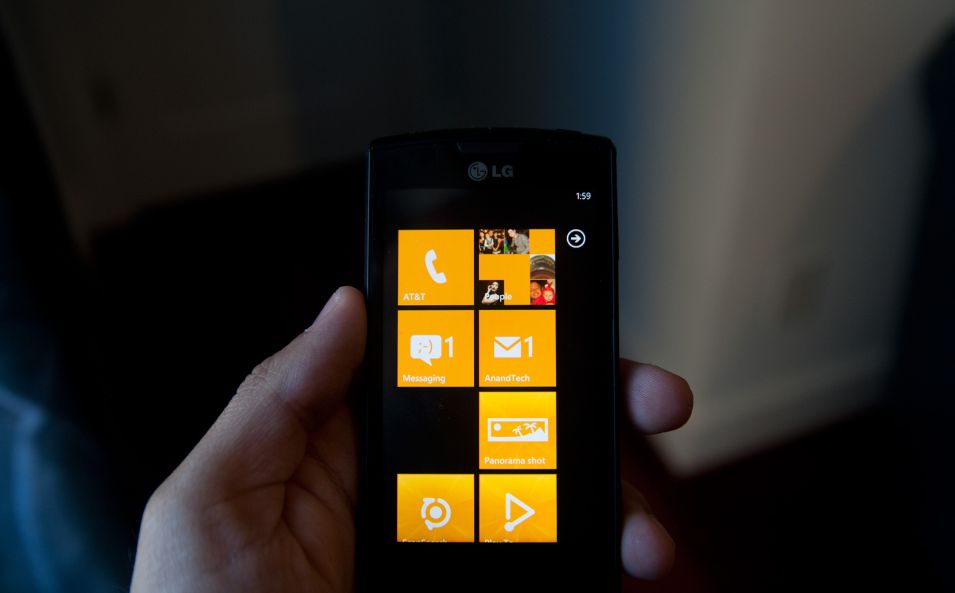
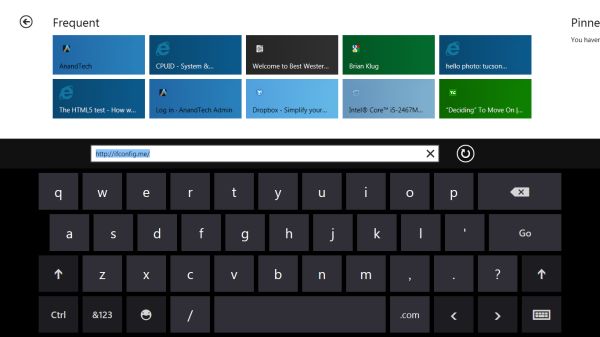
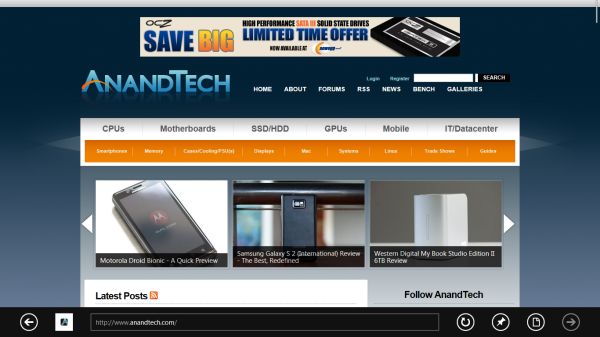
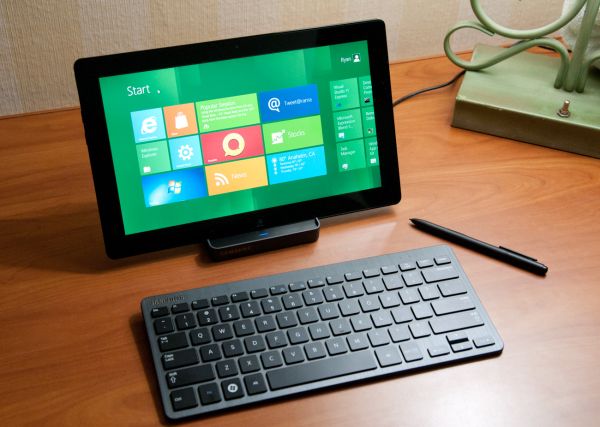
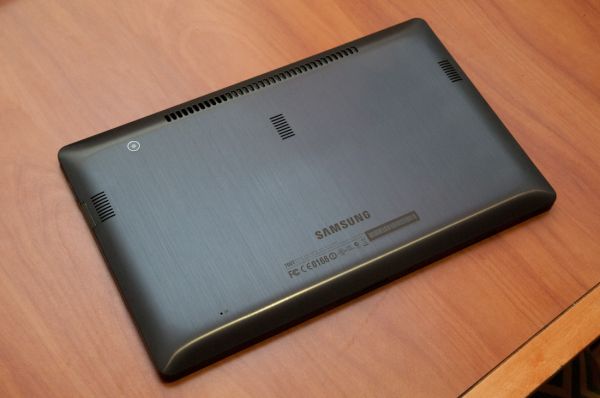
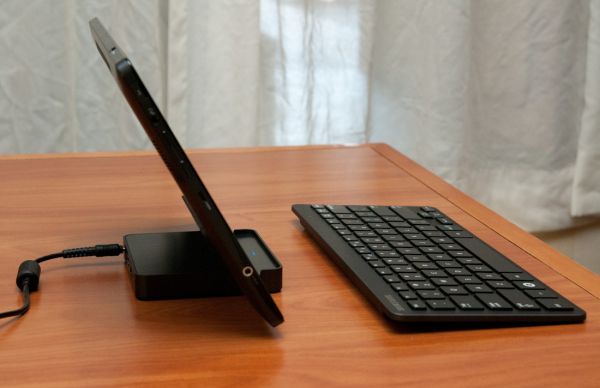








235 Comments
View All Comments
Ryan Smith - Tuesday, September 13, 2011 - link
"How will this upset the AV vendors, and how does it affect corporate users who can currently only use MSE if they have up to 10 machines?"Realistically I have to think AV vendors will be upset. You can easily disable Defender and replace it with other AV software, but this will hurt consumer sales. For businesses it's murkier. I can't imagine MS will turn off Defender if you have too many employees, but products like Symmantec's Endpoint Protection do more than just AV scanning and will probably remain desirable.
"Also, wouldn't it be a simple fix to allow the mouse-wheel to scroll left and right in the tiles display? Down goes left and up goes right?"
The mouse wheel currently works that way. The problem is that it's on a per-app basis, it isn't implemented in a universal fashion. Also, it's very slow to scroll that way with the wheel.
Kakureru - Tuesday, September 13, 2011 - link
the beginning of the end for useable open platform computing..TPM sucked ass when it was thought up and sucks ass now as implemented.
Sure its greeeeat to prevent a few pieces of malware but corporate abuse is more
of a danger than the viruses its sought to prevent.
A5 - Tuesday, September 13, 2011 - link
If you'd like cite your claim of TPM being used for "corporate abuse", that'd be great.CSMR - Tuesday, September 13, 2011 - link
Could someone explain: why is the start menu so small in the desktop?The links there are: Start, Search, Share, Devices, Settings
No recently used programs, no pinned programs, no all programs? No libraries?
How is accessing programs going to work on Win8?
UMADBRO - Tuesday, September 13, 2011 - link
Why not try our the developer release and find out?bupkus - Tuesday, September 13, 2011 - link
I'm hopeful that it will run on my HP Touchpad.rasueno - Tuesday, September 13, 2011 - link
does it play crysis?Ryan Smith - Tuesday, September 13, 2011 - link
I'm wishing I brought a copy of Crysis with me. I would have installed it on the Samsung tablet given the opportunity.Exodite - Tuesday, September 13, 2011 - link
So in the end Windows 8 is Windows 7 with an UI I hate?No thanks, I'll pass.
Over the last weeks we've seen some minor utility functionality previewed and I've tried my very best to keep fingers crossed that the many technical problems related to the OS will be addressed as well.
Not so it seems.
Essentially, from '95 onward the only real difference between releases have been a constantly changing UI and tacked-on convenience functionality. And the changing UI isn't a good thing, that's one area where consistency is paramount.
Personally I find what I've seen of the new UI to be a complete clusterfuck and the fact that we seem to get further and further away from the simplicity, power and elegance - let alone the intuitive interface - of a 20 year old OS (namely AmigaOS 3.x) is deeply troubling.
I don't want to advocate thrashing the entire code base and rewriting everything from the ground up but it seems more and more likely that's what it's going to take.
Oh well, my '92 Amiga still works.
Belard - Tuesday, September 13, 2011 - link
Hey... I used to run AmigaOS 3.0 on my Amiga 1000. :PI'm still not a lover of MS... but MS I see what MS is doing... it does make sense and they want to cater to the typical computer user, which is still a moron -er I mean, novice. I see teenager kids nowadays who grew up with computers that don't actually know how to USE a computer. Other than games, opening a browser to use facebook, email and IM and look at porn, that's about it.
For those in the work place, its about running a few apps (Word, email, quickbooks). So for many people, the desktop is either a clean place they rarely see or mess with hundreds of icons all over the desktop.
With the launcher and controls off to the side - which is a good place for these stupid 16x9 screens, it may means faster access to our apps and data on the computer.
I have 9 Apps open right now (Photoshop, Word, excel, Opera, Notepad++ (awesome - a text editor with tabs that remembers everything), various explorer windows. I can't see the icons, widgets or folders on the desktop itself. If its not on the taskbar - I'm not seeing it. So maybe, Metro/Win8 will work in the end.
Windows 8 is obviously about keeping control of the computer market... as iPad and MacOS are selling like mad - even Walmart proudly sells iPad2s - the marketing is more so than anything I've seen at a Walmart, oh well.
The removal of the F8 DOS is a step in the right direction... remember AmigaOS 2.0 and above from 1990 is still more advance than Windows7 in some ways.
I own an Android phone, which its GUI works like iOS. I run a WindowsPhone7 Launcher to replace the Android one... why? Its easier to use, its faster, it tells me info... I spent almost a year trying to find an app, my alarm, camera etc with my Samsung phone... I know where they are, but I maybe on the wrong screen or an icon gets moves. Whatever. The WP7 launcher works great for mobile devices... and an ACTUAL WP7 works even better.
I generally don't NOT like or trust Microsoft. In the end - it was Commodore that screwed us and killed the Amiga, not apple, not MS. I still have my Amigas... along with my Win7PC, ThinkPads and iPad. Whatever works.
If MS wants to improve upon what they have... a major change is needed.
Dos > Win3.0 / 3.1 > Win95 / Win98 > WinXP / WinXP > Win7 (weakest jump).
Hmmmm.... I think Microsoft may actually OUT-Macintosh Apple... that would be fun.
Windows 7 is the best MS has down for their desktop OS, finally. Its still a challenge for most humans. Win8's Metro interface is a GOOD move towards more elegane and simplicity over the OLD desktop. But MS *MUST* do a good job in making Win8 run properly with a mouse and keyboard. I'm fine with fingerprints on my iPad... Pros are NOT going to be putting their hands on their 24~30" screens to use PHOTOSHOP!!
PS: notice there was still a DOS Prompt: Icon in the Win8 preview.